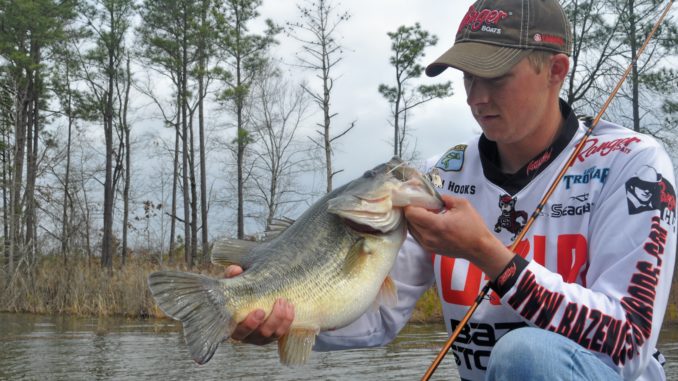
Harris, Falls or Jordan, which is the best of North Carolina’s best lakes for largemouth bass?
Fishermen having trouble choosing a month to target largemouth bass on the three lakes around the Raleigh-Durham area can get answers from two groups — serious anglers or biologists with the N.C. Wildlife Resources Commission — and they can take those recommendations to the bank(s).
Both groups agree that late March and the month of April are the best times to sample the best North Carolina has to offer, in the state’s “Golden Triangle” of bass fishing.
What’s going on in late March and April is no secret. Big female bass are staging just offshore, or they’re already on the banks, making beds to lay eggs or taking a number to wait their spawning turn with nearby male (buck) bass anxious to fertilize their eggs.
“We try to sample (by electro-shocking) when bass are spawning,” said Kirk Rundle, a fisheries biologist with the Commission. “We can’t wait until too late because the bigger bass move out into deeper water where we can’t get at ’em. So we try to corral them around the shorelines.”
March might seem a little early for bass to move toward the banks. After all, some of North Carolina’s biggest snows have occurred then, and temperatures in the past have dipped below freezing for four or five days in a row. But starting in February, daylight hours begin to grow longer, with more sunshine to raise water temperatures, and warm fronts begin to blow through.
Once bass sense three or four consecutive days of warm weather, they’ll move shallow and remain until finishing their spawn, even though later cold fronts may drop the mercury.
Nature planned the movements of bass to shorelines for late March and April when water temperatures start climbing toward the magical 68-degree mark. That’s when spawning hits its peak. It’s also when dedicated lunker thumpers beat the banks and biologists, wearing rubber boots and gloves and handling dip nets, cruise the banks in electro-shocking boats and scoop up fish for scale samples, measurements and tagging.
However, like any other natural process, success may vary.
“(Electro-shocking) depends on water temperatures,” Rundle said. “But there are other variables in getting good samples. It depends on weather, and where we start sampling. Timing has a lot to do with it. We might have to juggle lake sampling around anadromous shocking, such as this year at the Tar River. Plus, at the Tar, we have to go when the water is up; that might mean we miss a day or two at a lake during the height of the spring spawn.”
It also means snapshots of a lake’s bass population and fish health often vary from year to year on graphs, but not in the water.
“It doesn’t mean a great deal if the numbers of fish we find differ from one year to the next,” Rundle said. “If we sample fewer — or more — bass than the previous year, nothing may have changed. We look at long-term results and trends.”
So those who study the graphs at the Commission’s web site — www.ncwildlife.org/Fishing/Learn-Resources/Monitoring-Surveys — shouldn’t be alarmed or elated by lower or higher numbers at their favorite Triangle lunker hole.
“The main indicator of how healthy a lake is depends mostly on long-term body conditions, growth rates and numbers of fish above, at or less than keeper sizes or fish in slots,” Rundle said.
Here’s a look at the three Raleigh-Durham area lakes that once again should rate 1-2-3 in North Carolina this year.
Shearon Harris Lake
This 4,151-acres lake is almost entirely within Wake and Chatham counties.
Shaped roughly like a “Y”, with three main sections and several feeder creeks, Harris is about 20 miles southwest of Raleigh off US. 1, and owned by Duke Energy, which runs a nuclear power plant on its northwestern shore.
What makes Harris the a top bass lake is obvious — its habitat resembles a Florida lake ,with nearly every foot of shoreline touching huge beds of aquatic vegetation. The hydrilla, primrose and elodea tangles rimming the lake offer excellent hiding and rearing spots for baitfish, and that sets the table for largemouths.
Harris has minimal hard shoreline structure, but bass, being ambush predators, love its grassy perimeter. It does have riprap at the New Hill/Holleman Road causeway, the only road that crosses its waters.
“During a February tournament last year, the winning team had a five-bass limit of 42 pounds,” Rundle said. “That’s almost 81/2 pounds per fish.”
The next week at Harris, winning anglers caught a five-fish total weight that eclipsed 40 pounds.
In addition to Harris’s aquatic grass, it’s unique because of a 16- to 20-inch “no-keeper” slot that’s created a trophy pool.
“I think about Harris as a really, really good bass pond,” Rundle said.
Favorite lures for guide Jeff Thomas of nearby Broadway include a lipless crankbait in shallow water, a floating worm he rigs wacky style with a TroKar drop-shot circle hook and a blue/black jig’n’pig or a creature bait he flips to the bases of willow trees in spawning coves.
Fisheries biologist Jessica Baumann has helped coordinate Harris bass studies for 10 years. Her 2017 data showed 41 percent of 358 sampled fish inside the 16- to 20-inch slot limit, 50 percent below the slot, and 9 percent longer than 20 inches. Of all bass sampled, 64 percent were 14 inches or larger.
As far as age classes, in 2015, 65 of 406 sampled bass were age 5, 40 were age 2, 32 were age 4, 38 were age 6, 30 each were ages 7 and 8, 10 were 9 and 11 bass reached age 11.
“The capture ratio (catch per unit effort or CPUE) for all lakes averages 30.60 bass per hour,” Rundle said.
Sampling in odd-numbered years, the Commission’s data showed that bass were shocked up at rates between 59 and 96 per hour, the latter a record in 2013, giving Harris double the bass of an average Piedmont lake.
Falls of Neuse Lake
At 12,491 acres, this lake in northern Durham and western Wake counties is three times the size of Harris. It features the Neuse River channel coursing through its 26-mile trip from headwaters to dam, plenty of large and small feeder creeks, three major road crossings, five state recreation areas, one large commercial marina and nine boat ramps.
Falls’ key feature for spring fishing is hard shoreline structures, from laydowns to buck brush, flooded willows, rocks from pea gravel to automobile size, riprap on the sides of causeways and standing timber — plus big spawning flats.
“Our CPUE (in electro-shocking) for Falls bass in 2015 was 63 (bass per hour),” Rundle said. “The relative body score (length-to-weight ratio) is 93, which is good.”
It also compares well to Harris’s 97 relative body score.
Keeper size on Falls is 14 inches, and 38 percent of bass electroshocked there were 14 inches or better. Five percent of Falls bass taped 20 inches or longer.
Falls Lake’s female score was a near-perfect 99 for body condition in the 20- to 25-inch range, which bodes well for the future.
“If I were looking to catch a trophy largemouth bass, I’d start at Harris, then try Falls,” said Rundle.
Pro angler and guide Joel Richardson likes two lures that make plenty of commotion on the surface at the end of long casts.
“I’m not saying a spinnerbait isn’t good for spawning fish, but I’ll use it only where there’s dirtier water, which you often get after a rain,” he said. “If I go to the back to a cove and find dingy water, that’s when I’ll throw the spinnerbait.”
He prefers a 3/8-ounce buzzbait in white or white/chartreuse. If bass aren’t hitting a buzzbait, he’ll switch to a Texas-rigged lizard or a 7-inch floating trick worm in chartreuse and white.
Jordan Lake
Part of the Haw-Cape Fear river drainage, this 13,022-acre lake also has bass numbers and sizes comparative to Harris and Falls lake.
“Bass health is great at Jordan,” said Corey Oakley, a fisheries biologist for the Commission who oversees Jordan. “At our (2015) sampling, we got 320 fish, with 13 percent longer than 18 inches and 7 percent more than 5 pounds.”
Data indicates that bass grow from 6 inches at one year to 18 inches at five years, giving them the “football” shape that’s made them famous. An 11.1-pound bass was shocked up as part of a 2012 survey.
Fifty-five of those largemouths were a year old and 6 inches long. Five years later survivors averaged 18 inches long. Sampling in 2016 put CPUE at 49 bass per hour, one year after sampling corralled 81 per hour.
With two main tributaries (Haw River and New Hope Creek), Jordan’s outline resembles Harris more than Falls. NC 751 crosses two eastern creeks, while US 64 transverses its center east-to-west. Many submerged road beds and one flooded railroad track provide excellent bottom structures.
Thomas usually starts his spring days around the causeway next to the Ebenezer Church access area, along the riprapped bank.
“It’s a perfect place to find bass that will spawn in Beaver or Little Beaver creeks,” he said. “I’ll throw a Shad Rap or spinnerbait 2 or 3 feet off the riprap and parallel to it.”
Two other productive pring spots are the shallow back of White Oak Creek with its flooded willow bushes, and tiny coves on the east side of Bush Creek as it leads to a sheltered crappie flat.
Once the water temperature reaches the mid 60s, big females will orient at willow roots in 1 foot of water and slam jig’n’pig lures in those little coves.

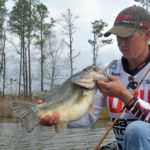
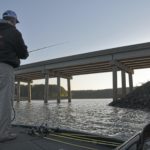
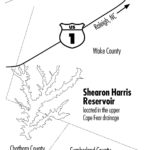
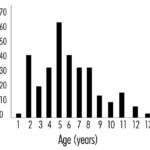
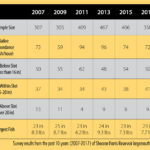
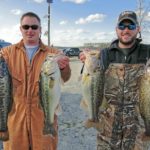
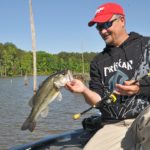
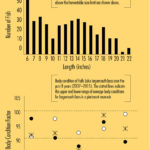
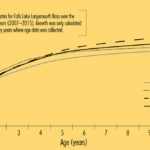
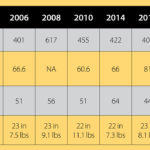
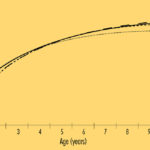


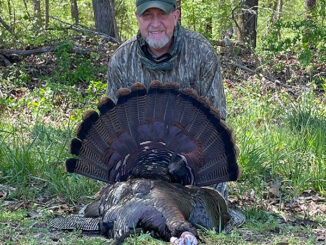

Be the first to comment